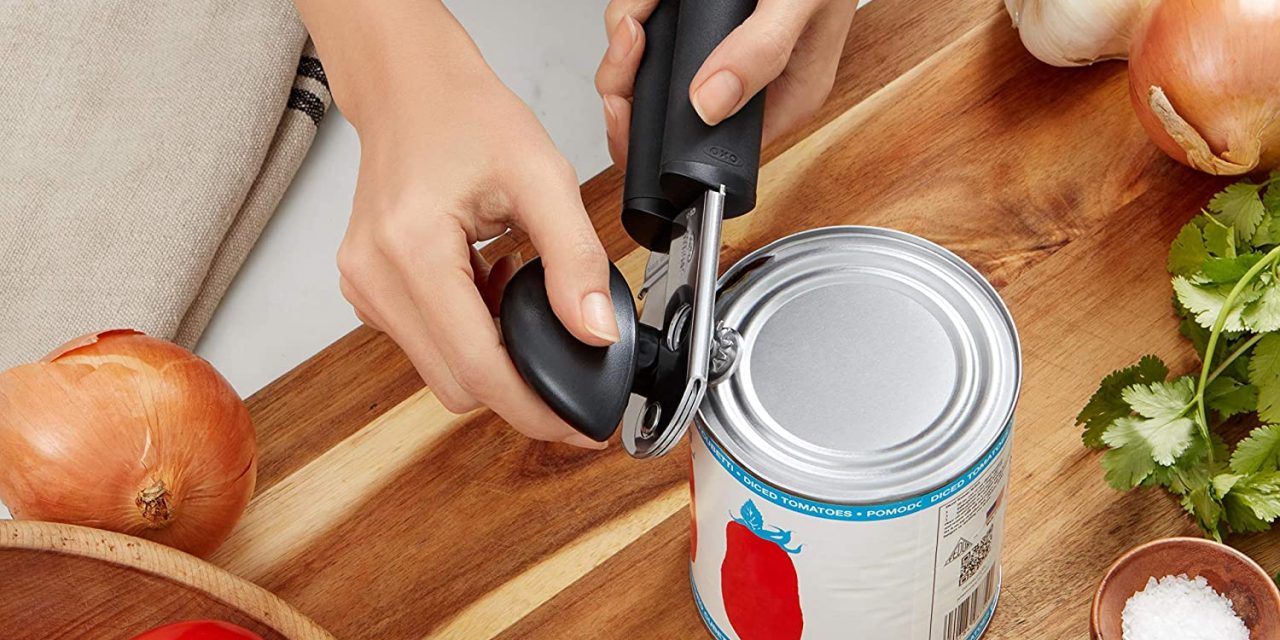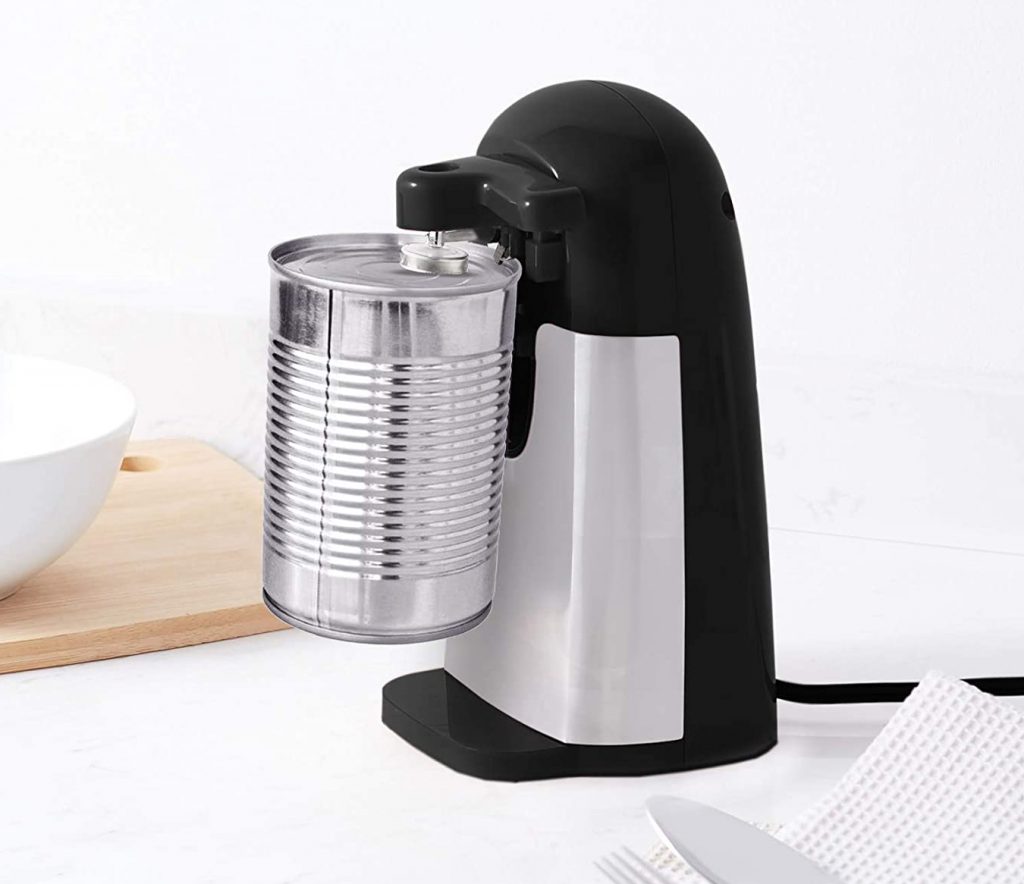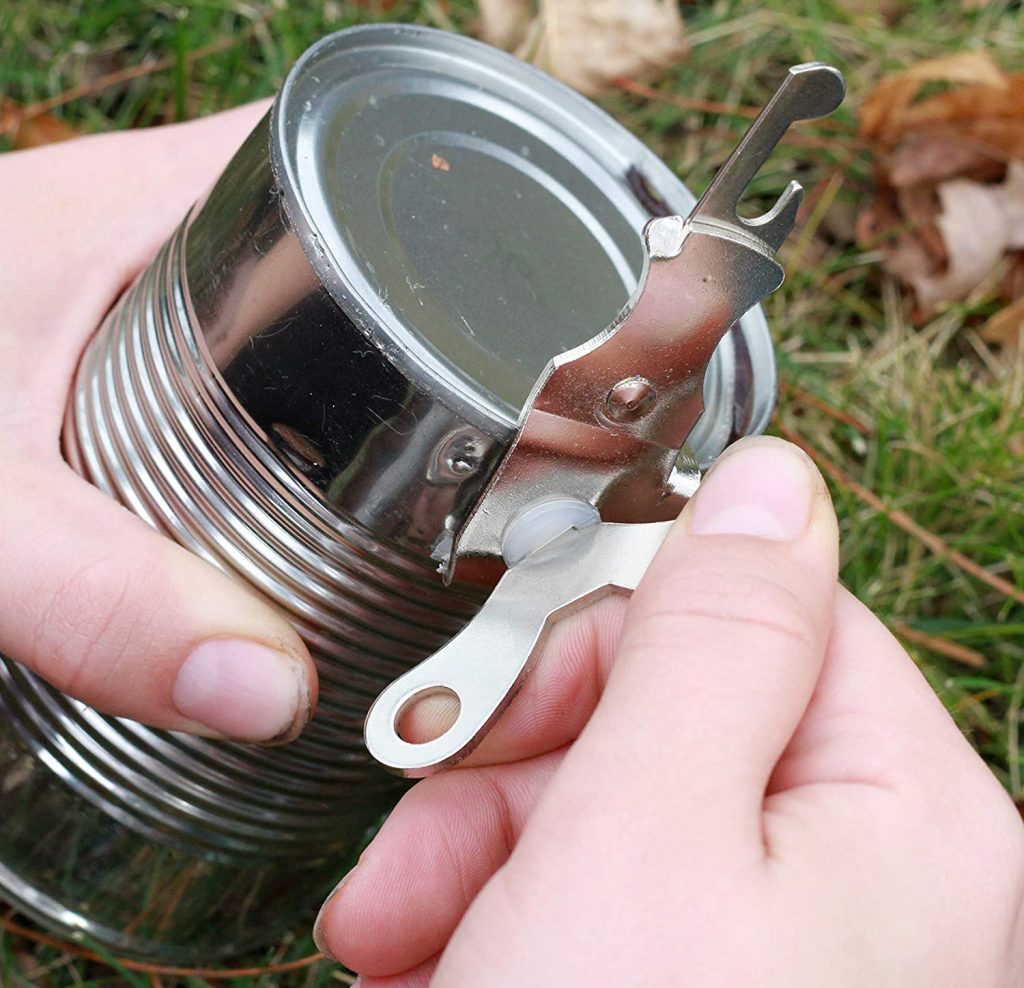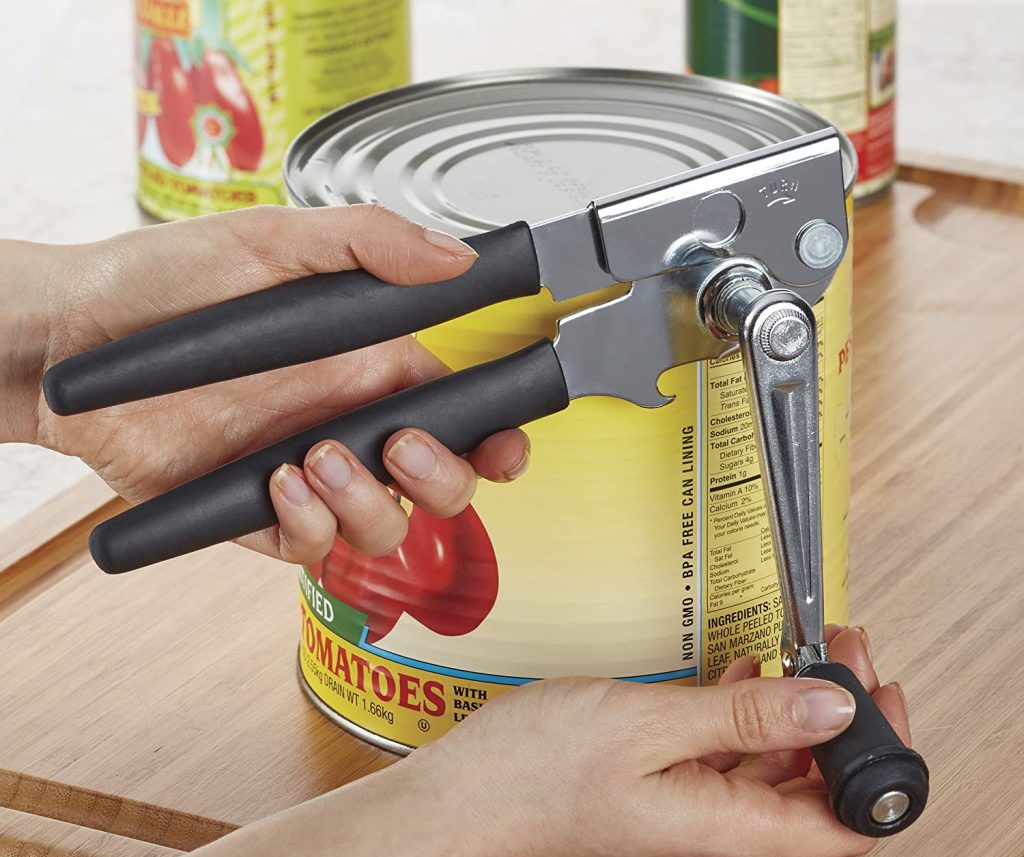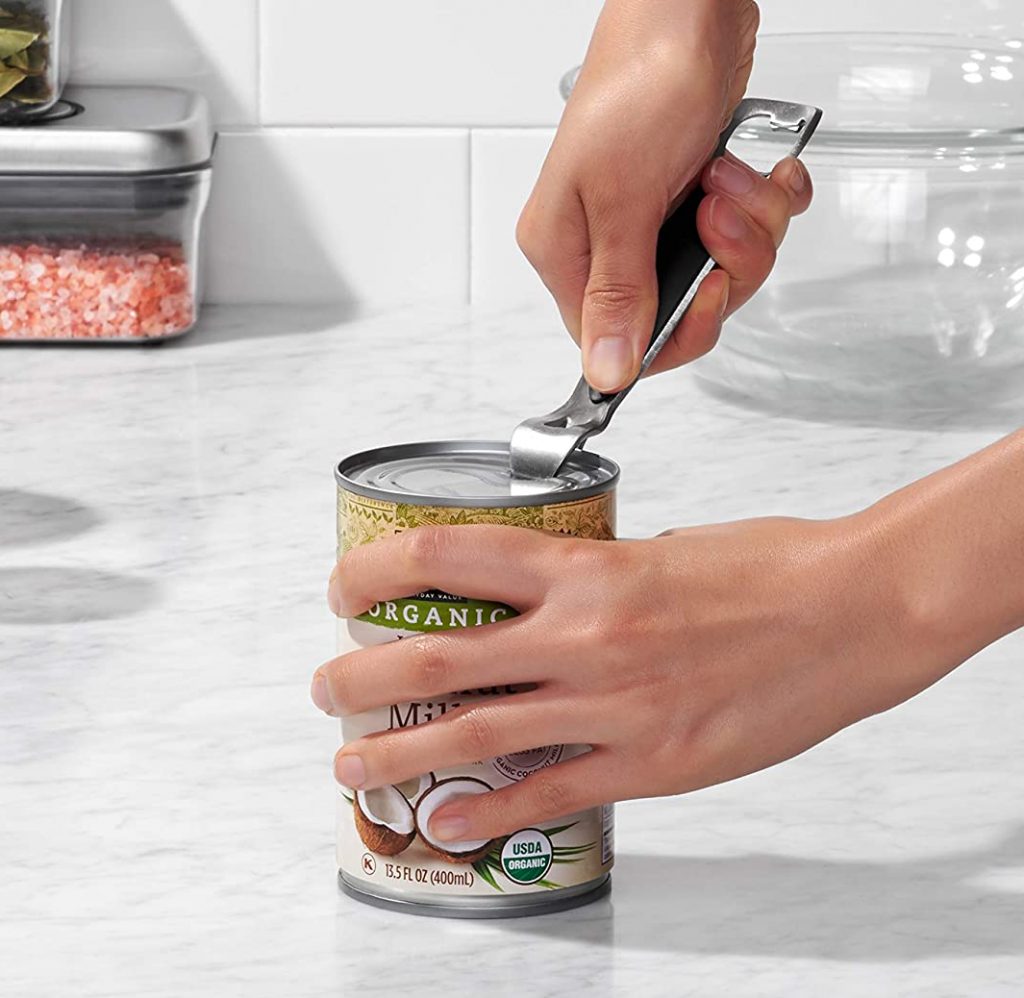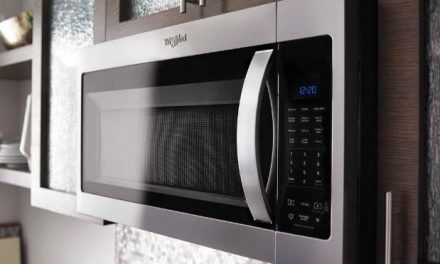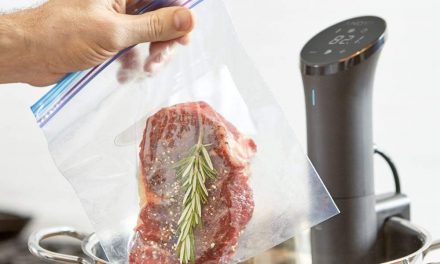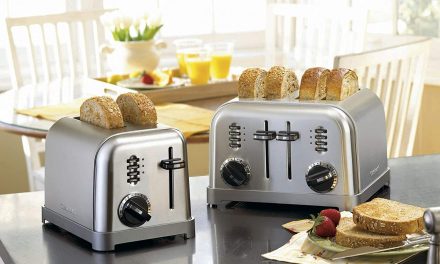We’ve come a long way since the early knife-type variations of can openers, so much so that now you have the option of choosing between manual and electrical ones. Whether you have arthritis or are looking for a simpler way to get access to canned goods, we’ve got you covered.
Types of can openers
There are two main types of can opener, the more modern, automatic electric style and the more traditional, manual style. There are pros and cons to both, and in the case of manual can openers, there are many styles to choose from within that category.
Automatic can openers (electric can openers)
Automatic can openers, also referred to as electric can openers, feature a magnet in their construction that holds the can in place for you. While a connecting gear spins the can, a blade cuts into the top. Most automatic can openers slice into cans in a way that means there is no sharp edge left to cut yourself on. That means automatic can openers require zero human effort (unless you count placing the can under the opener) and no risk of injury.
If you have trouble working manual can openers, due to achy joints, weakness, or stiffness of the wrists, automatic can openers will suit you perfectly. However, they can be harder to clean, and because electric can openers run on electricity, they won’t do you much good in the event of a power outage. But, fear not, you can also opt for the battery-operated version of automatic can openers to dodge that proverbial bullet.
Corded electric can openers
If you’re looking for a can opener that can deal with all types of cans, including pop-tops and standard ones, without any exertion on your part, look no further than corded electric can openers. Their construction includes a durable, almost rectangular body with a magnet to hold the can in place as the gear and blade do their work.
Corded electric can openers are available in various sizes, designs, and color variations; however, most are pretty compact to make for easy storage. There’s also usually a handy area to tuck and store the wire. As far as cleaning is concerned, some brands include a removable and washer-friendly lever, although you’ll have to wipe the blade clean with a cloth.
What are the pros and cons of corded electric can openers?
These can openers have several advantages, such as minimal exertion for use, complete safety, and the ability to open all types of cans. Besides that, electric openers also tend to make smoother, cleaner cuts that don’t leave any jagged edges you need to look out for.
Some brands manufacture openers with removable levers for ease of cleaning. And, believe it or not, there’s not much of a price difference between battery-powered and electric can openers. Most are sold for between $16 and $45, with cheaper and more expensive models available in both styles.
Drawbacks to these electric can openers include extra space to store the machine and the fact that the devices need power to run.
Cordless, battery-operated can openers
Cordless battery-operated can openers feature a streamlined, sturdy plastic body that latches onto the can while cutting. This is a very ergonomic design, and all you’re required to do is place the opener on the can for some quick cutting. Some top-end cordless can openers also come equipped with a bend blade that allows the opener to cut along the lid without leaving sharp edges, which will protect your hand from scratches and cuts.
Finally, most battery-powered can openers run on AA batteries and include a button for power on/off. Cleaning the device requires you to wipe the blade with a damp cloth because washing underwater or in the dishwasher isn’t an option at all.
What are the pros and cons of corded electric can openers?
One of the most significant advantages of cordless battery-operated can openers is that they require little to no effort on the user’s part. Plus, there’s the benefit of cutting along the lid, which allows you to access the food inside the can without the fear of scrapes and cuts.
There’s also the added convenience of being battery-powered (which means you don’t have to worry about power cuts), and cleaning the device requires a simple wipedown with a damp cloth.
However, cordless can openers can be just as useless as electric openers without power if you run out of batteries. So always remember to keep a steady supply of batteries on hand. Additionally, users have complained of some models tumbling off the can while cutting along the lid, which can be annoying.
Manual can openers
As the name suggests, a manual can opener requires human effort to operate the device, along with a fair bit of technique in some cases.
Much like electric can openers, most (though not all) manual can openers have a blade and a gear, too—only both are attached to a handheld tool. You use the opener by pressing the blade against the lid of the can and squeezing the handles together so that the gear is wedged against the other side. This allows the blade to pierce the can and enables the gear to turn the can as you rotate the lever. Again, this accounts for most manual openers on the market, but not all.
The theory behind manual can openers sounds simple enough, but the actual practice takes a bit of learning, and even then, it can be an irritating process as the can may slip sometimes or the opener itself may be difficult to use. Suffice it to say, manual openers are not for folks who are short on time or don’t have a powerful grip.
Bunker can openers
Bunker openers have the honor of being the most popular type of manual can opener. They include plier-like handles, a serrated blade wheel, a lever or key, along with a gear to help the can rotate. However, unlike side can openers, bunker openers offer buyers a more unproblematic user experience. You need to operate the key on top of the gadget to use the can opener.
What are the pros and cons of bunker can openers?
Even though bunker can openers require you to exert some effort, they have the advantage of being more user-friendly, thanks to the solid, easy-grip handle design and key.
Plus, most bunker openers (with a durable plastic body and steel blade) are dishwasher safe – so cleaning isn’t a problem. Despite all that, bunker openers cut into the lid, rather than along the side of the can, which means there’s often an element of a safety hazard with sharp edges left on the can and lid.
Butterfly can openers
Butterfly can openers generally have an all-steel construction and likely get their name from the butterfly-like shape of the key. These include a church-key design (a pointed tip) used to pierce the can. Next, ensure the opener has a firm grip on the lid (with the sharp wheel at the back) and use the key to cut open the cover by rotating it.
What are the pros and cons of butterfly can openers?
Butterfly can openers are durable, super-compact, and very easy to store and clean. In fact, these are probably perfect for any hiking trips you’re planning. They usually feature a handy little bottle opener, too. However, the drawback to these can openers is that they’re hand-operated and require you to exert force to cut a can’s lid open. In general, they’re more difficult to use than some other manual openers.
Crank can openers
Crank can openers are built like regular manual can openers with the handles, the serrated blade, and the works. But, here’s where they differ: crank openers feature a durable crank instead of a lever or key that helps you control the gadget.
These openers typically include a steel body with cushion grips on the plier-like handles and a large crank handle. They’re pretty compact but bigger than, say, butterfly openers, which invariably means more storage space is required for them.
What are the pros and cons of crank can openers?
Crank can openers are easier on the hands because the design puts less strain on your fingers thanks to the use of the crank. However, they’re still manually operated, which means there’s no hands-free advantage like with electric can openers.
Most crank openers on the market are dishwasher safe, but some require handwashing, so cleaning the gadgets won’t necessarily be a problem. The downside to crank openers is that they need a two-hand operation and aren’t suitable for the elderly or folks with weakness or numbness of the hand.
Church key can openers
Church-key can openers resemble old-school bottle openers, but they feature a pointed metal tip that helps pierce into the lids of cans. Note the word pierce, not cut. These ‘can openers’ are ideal for flat-topped juice or beer cans but are not very helpful for cans with food items, which require removal of the entire lid.
You can use a church-key can opener by ensuring the guard (that helps the opener stay in place) is placed firmly on the can’s edge and then press down on the opener to puncture the lid.
What are the pros and cons of church key can openers?
These can openers are ideal for beer and juice cans because they can easily pierce a can without too much hassle. However, they’re not suitable for buyers who need an opener to do away with the whole lid.
Church-key openers are also constructed as a single piece of pressed metal, so they’re both durable and don’t need too much space to store. They’re also dishwasher safe.
What are safety can openers?
The one problem prevalent in can openers with an angled blade is that when they slice through the metal, they leave behind a super-sharp inner rim that can cause all sorts of trouble.
That’s where safety can openers can help you out. They look like ordinary can openers, but instead of being placed on the side, the gears on safety can openers are placed on top. On a safety can opener, the blade (being situated on the side) will cut right along the can’s rim and smoothly do away with the entire lid. The edge left behind by them is dull to the touch, meaning you don’t have to worry about inadvertently cutting yourself.
One downside? Because safety can openers slice the can upon by cutting its sides, where the metal is thicker, their blades tend to wear out faster than openers that open the can by cutting the lid.
On the whole, if you’re looking for an opener that puts safety first, you can’t do much better than a safety can opener.
Can opener starter kit
Who knew there were so many types of can openers out there? If you’re feeling a little out-of-sorts with the sheer volume of choice you face, check out the below to help get you starter.
- If you’re not a fan of cooking at home and don’t use your kitchen too often to prepare meals, it’s pointless to invest in an electric can opener. However, a good-quality can opener is something all kitchens should contain because you never know when you might need one. That’s why you should opt to buy a manual safety can opener, like Good Cook’s.
- Do you have arthritis or weakness/numbness of the hand? If yes, then we’d recommend Kitchen Mama’s cordless battery-operated can opener. This gadget runs on batteries, requires little to no effort on your part, and is easy to clean and store.
- If you’re part of a large family with a love of home-cooked meals, it’s likely canned food items take up some serious space in your pantry. We advise you to go for a corded electric can opener, like Hamilton Beach’s, because they can run almost endlessly on electricity and are suitable for all types of cans. Sure, these can openers come with a base and take up a bit of room, but some of the latest electric can openers on the market are designed not to use up too much space, and they’re stylish to boot. If you live in an area that’s prone to brown-outs, you may also want a backup manual can opener.
- A fan of outdoor adventures? Then you’ll definitely benefit by investing in a sturdy, low-cost butterfly can opener, such as the one by Chef Craft. Like many butterfly openers, this one also includes a bottle opener. What’s not to like about the ‘two for the price of one’ bargain?

